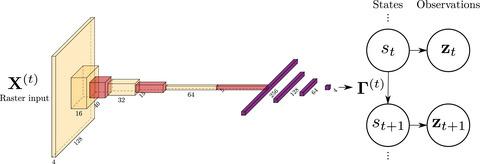当前位置:
X-MOL 学术
›
Ecol. Lett.
›
论文详情
Our official English website, www.x-mol.net, welcomes your
feedback! (Note: you will need to create a separate account there.)
Neural hierarchical models of ecological populations.
Ecology Letters ( IF 7.6 ) Pub Date : 2020-01-23 , DOI: 10.1111/ele.13462 Maxwell B Joseph 1
Ecology Letters ( IF 7.6 ) Pub Date : 2020-01-23 , DOI: 10.1111/ele.13462 Maxwell B Joseph 1
Affiliation

|
Neural networks are increasingly being used in science to infer hidden dynamics of natural systems from noisy observations, a task typically handled by hierarchical models in ecology. This article describes a class of hierarchical models parameterised by neural networks - neural hierarchical models. The derivation of such models analogises the relationship between regression and neural networks. A case study is developed for a neural dynamic occupancy model of North American bird populations, trained on millions of detection/non-detection time series for hundreds of species, providing insights into colonisation and extinction at a continental scale. Flexible models are increasingly needed that scale to large data and represent ecological processes. Neural hierarchical models satisfy this need, providing a bridge between deep learning and ecological modelling that combines the function representation power of neural networks with the inferential capacity of hierarchical models.
中文翻译:

生态种群的神经层次模型。
神经网络在科学中越来越多地用于从嘈杂的观测中推断自然系统的隐藏动态,这通常是由生态学中的分层模型来完成的。本文介绍了由神经网络参数化的一类层次模型-神经层次模型。这种模型的推导模拟了回归和神经网络之间的关系。针对北美鸟类种群的神经动态占用模型开发了一个案例研究,对数百种物种的数百万个检测/非检测时间序列进行了训练,从而为大陆范围的定居和灭绝提供了见识。越来越需要灵活的模型来扩展到大数据并代表生态过程。神经层次模型可以满足这一需求,
更新日期:2020-01-23
中文翻译:

生态种群的神经层次模型。
神经网络在科学中越来越多地用于从嘈杂的观测中推断自然系统的隐藏动态,这通常是由生态学中的分层模型来完成的。本文介绍了由神经网络参数化的一类层次模型-神经层次模型。这种模型的推导模拟了回归和神经网络之间的关系。针对北美鸟类种群的神经动态占用模型开发了一个案例研究,对数百种物种的数百万个检测/非检测时间序列进行了训练,从而为大陆范围的定居和灭绝提供了见识。越来越需要灵活的模型来扩展到大数据并代表生态过程。神经层次模型可以满足这一需求,











































 京公网安备 11010802027423号
京公网安备 11010802027423号